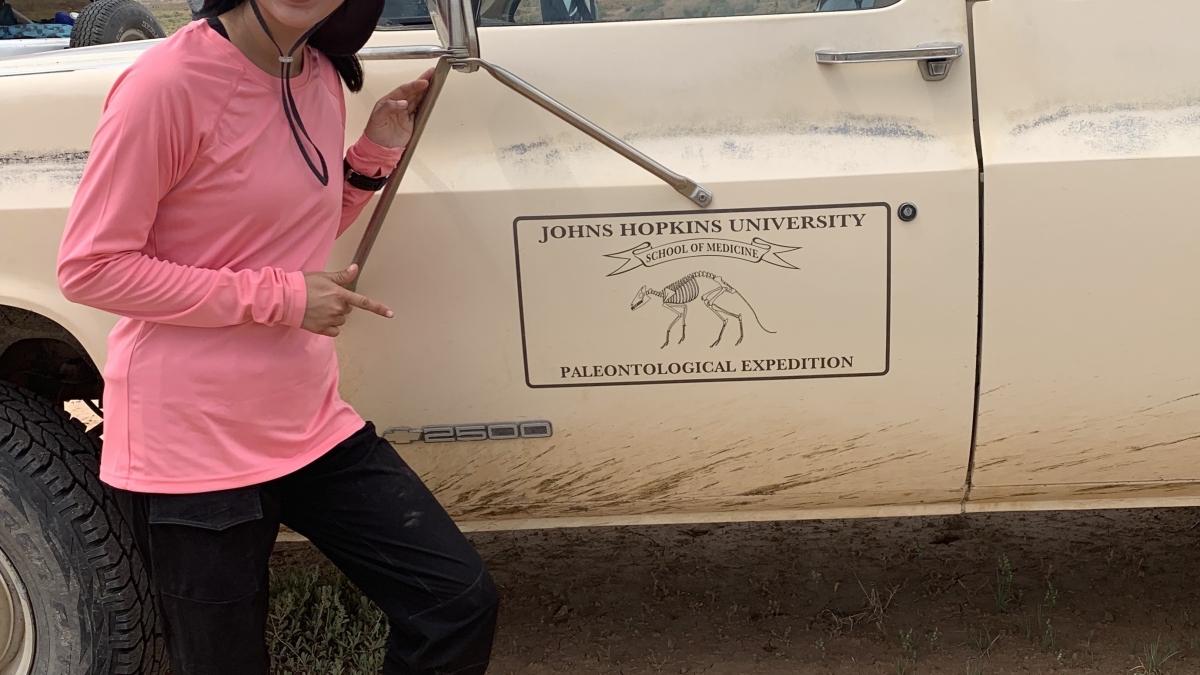Scholarship funds student paleontology fieldwork

Gomez poses next to a fieldwork truck in Bighorn Basin, Wyoming.
Kinesiology junior Cassaundra Gomez was sitting in BIO 102 last spring at Arizona State University’s Downtown Phoenix campus when she first learned about a unique opportunity.
Her anatomy and physiology lecturer Tonya Penkrot was telling students about a fieldwork trip over the summer in Bighorn Basin, Wyoming, that would give them hands-on experience in paleontology.
“She mentioned it in class, and I was like, ‘I’m down. That sounds exciting,’” Gomez said.
When she signed up, Gomez said she didn’t really know what to expect from the trip, but that she ended up learning a lot and enjoyed the adventure.
“It’s really interesting to learn from (fossil mammals) because we’re mammals. You find lots of teeth and from that you can learn what their diet needs were like.”
Gomez doesn’t plan to go into paleontology, but she said the fieldwork was still insightful to her kinesiology studies.
“It further reinforces anatomical knowledge and gave me a better idea about bone structure,” Gomez said.
Gomez received financial support to go on the fieldwork trip by using the Scholarship Honoring Anatomy and Physiology Education and Research (SHAPER), which is funded from the royalties of the BIO 201 and 202 course lab manual fees.
Penkrot and fellow anatomy and physiology faculty members Jeff Kingsbury, senior lecturer, and J. P. Hyatt, associate professor, collaborated with then-lab manager Jennifer Legere to create a lab manual to better serve student learning and to build funds for a scholarship students can use for research, application fees, conference fees or other special educational opportunities in the realm of anatomy and physiology.
Penkrot wants to create opportunities like the ones she experienced when she was in school, because she knows what a big impact they can have on students.
“When I was an undergrad, my adviser knew I was interested and helped put me in contact with a person who knew another person who did fieldwork in Wyoming,” Penkrot said. “That simple act, it changed the course of my life.”
That person ended up becoming Penkrot’s thesis adviser, Kenneth D. Rose, emeritus faculty at John Hopkins University School of Medicine, who still organizes that same fieldwork trip annually. Once participants arrive in Wyoming, his group sets up a campsite from which they go out each day to various localities to look for fossil mammals.
“I thought there would be a lot of digging, but really you just walk around and look on the ground," Gomez recounted of their daily activities. “Everyone usually thinks paleontology is dinosaurs, but we’re actually looking at mammals.”
At the end of the day, participants return to camp and compare what they found with each other, then carefully package up the fossils to be transported to Rose’s lab, or to the Denver Museum of Natural History for permanent cataloguing and housing.
Penkrot said studying fossils is important to better understand how things have evolved, and she hopes that experiences like this help students see the value in natural resources.
“I hope that students will get an appreciation and a sense for why it is so important to preserve and protect all natural resources, not just those that have a dollar value attached to them. Places like the Bighorn Basin represent irreplaceable records of a part of the history of life on Earth, and deserve to be studied, protected and managed responsibly,” Penkrot said.
Gomez is appreciative of the opportunity and highly recommends the trip to her fellow classmates.
“It was definitely a great experience,” Gomez said. “I would do it again if I could.”
More Science and technology

ASU professor breeds new tomato variety, the 'Desert Dew'
In an era defined by climate volatility and resource scarcity, researchers are developing crops that can survive — and thrive —…

Science meets play: ASU researcher makes developmental science hands-on for families
On a Friday morning at the Edna Vihel Arts Center in Tempe, toddlers dip paint brushes into bright colors, decorating paper…

ASU water polo player defends the goal — and our data
Marie Rudasics is the last line of defense.Six players advance across the pool with a single objective in mind: making sure that…

